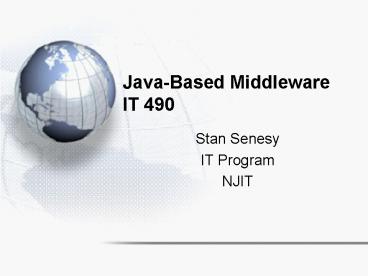JavaBased Middleware IT 490 - PowerPoint PPT Presentation
1 / 16
Title:
JavaBased Middleware IT 490
Description:
Java Message Service (JMS) is an application framework that ... possible, use an adapter to insulate both the target application and the integration server ... – PowerPoint PPT presentation
Number of Views:47
Avg rating:3.0/5.0
Title: JavaBased Middleware IT 490
1
Java-Based MiddlewareIT 490
- Stan Senesy
- IT Program
- NJIT
2
Java-Based Middleware
- Categories
- Database oriented
- The most mature element of Java-based
integration. Includes the JDBC specification - Interprocess
- Remote Method Invocation (RMI). Analogous to RPC
without many of the problems associated with RPC - Message Oriented
- Java Message Service (JMS) is an application
framework that provides an API to allow message
level connectivity between JMS compatible systems.
3
Java-Based Middleware
- Categories
- Application Hosting
- Using an application server allows a Java app to
serve as an entry point to centralized resources. - Connectivity
- Java Connector Architecture (JCA) provides a
standardized interface for integrating Java2
Enterprise Edition (J2EE) applications amongst
Enterprise Information Systems (EIS)
4
Java-Based Middleware
- J2EE
- J2EE provides XML support through the Java API
for XML Processing (JAXP). This gives the
capability to verify, create, access and
manipulate XML documents directly from within
Java - JAXP specifications include
- Java API for XML Messaging (JAXM) which allows
transmission and reception of SOAP messages - Java API for XML Registries (JAXR) provides a
uniform standard for interacting with XML
registries such as UDDI or ebXML - Java API for XML-based RPC (JAX-RPC) gives
developers access to a Java based RPC library
based on the SOAP specifications
5
Java-Based Middleware
- Transactional J2EE
- Java transactions are supported through the used
of the Java Transaction API (JTA). - JTA enables high-level transaction processing in
a distributed environment - Messaging J2EE
- Java Messaging Service (JMS) is a growing
middleware standard that has attracted a wide
variety of existing middleware vendors
6
Java-Based Middleware
- Distributed Application J2EE
- RMI provides a limited capability to interact
with other distributed object middlewares such as
CORBA - The RMI-IIOP extensions provide an addition to
the Java RMI that allows much greater interaction
and integration with CORBA ORBs. - RMI-IIOP allows developers to connect the two
middleware standards together natively, with no
transactional binding needing to be implemented
7
Integration ServersIT 490
- Stan Senesy
- IT Program
- NJIT
8
Integration Servers
- Integration servers broker information between
on or more target entities with greater ease than
traditional middleware models - Services that are provided by integration servers
include - Transformation
- Intelligent Routing
- Rules Processing
- Message warehousing
- Flow Control
- Respository services
- Directory services
- Management
- APIs and adapters
9
Integration Servers
- Most middleware solutions that weve explored so
far only deal with portions of the middleware
problem. - Functions such as routing, data format and flow
control are not part of a typical middleware
package - Integration servers help this problem by
providing a standardized set of services that may
be applied across a number of differing
middleware domains
10
Integration Servers
- Integration servers provide a number of differing
communications models, including - One-to-one
- One-to-many
- Many-to-many
- Any-to-any
11
Integration Servers
- In evaluating the applicability of an integration
server, we need to take the following steps - Evaluate the systems to be integrated. APIs that
are available should be indentified - Use existing APIs to serve as entry points into
existing applications (preventing a rewrite) - Whenever possible, use an adapter to insulate
both the target application and the integration
server
12
Integration Servers
- Lets look at some integration server services
more in depth - Transformation Layer
- We need to provide a standardized data
representation for all systems to be integrated.
The functions here include pattern matching,
parsing, etc. - Schema Conversion
- Database schemas must also be compatible (data
federation). This layer is responsible for the
conversion to/from a common schema
13
Integration Servers
- Data Conversion
- In addition to changes to the schema, we might
need to make changes to the physical data
structure as well. - Intelligent Routing
- Messages need to be routed to the server that is
best available to process them. Often, only the
integration server itself can make that
determination - Rules Processing
- Data constraints might require knowledge from
separate systems to determine the applicability
of rulesets
14
Integration Servers
- Message Warehousing
- It may become necessary to retrieve information
for a period of time. Warehousing provides a
persistent storage location for that data - Repository Services
- Central location of information about source and
target applications (metadata, etc) - User Interface
- Common location for the serving of a GUI that
allows access to the interfaced systems
15
Integration Servers
- Directory Services
- Allows integrated applications to intelligently
locate any data on the network. Examples include
DNS, Netware, Active Directory, etc. - Management
- System management of the various applications
that are integrated. Current management tools
include elements that utilize SNMP. - Adapters
- A common wrapper that allows easier integration
than rewriting an application from scratch.
16
Integration Servers
- Topologies
- Hub-spoke
- Multihub
- Federated































